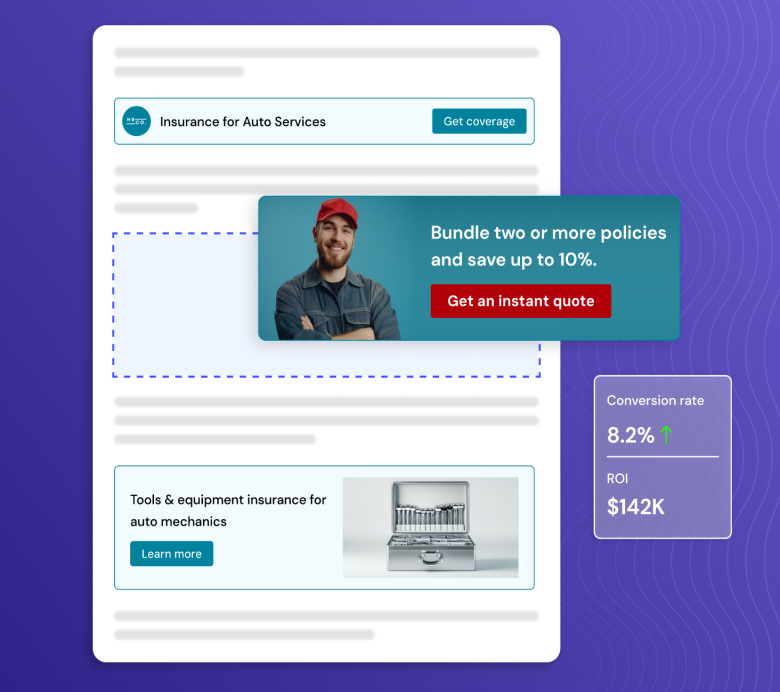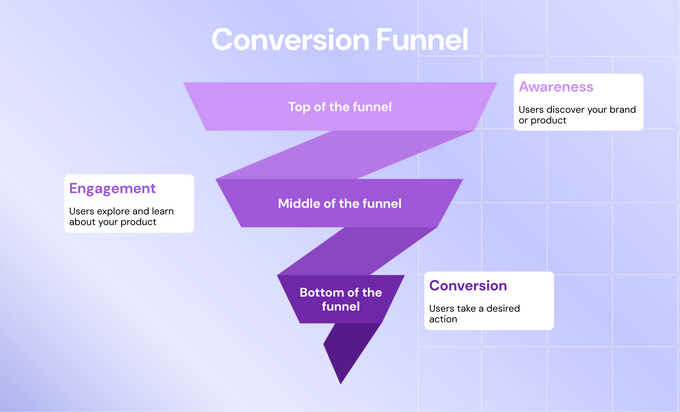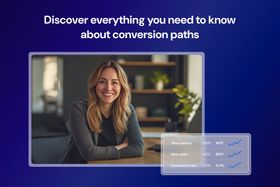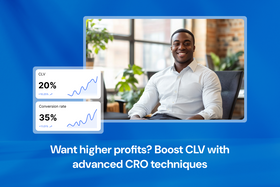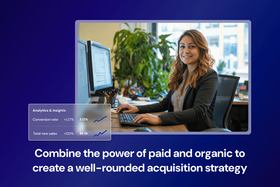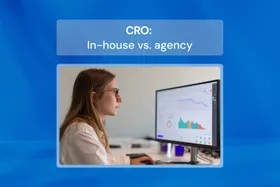Conversion funnel optimization: 10 advanced strategies
Discover advanced strategies to plug invisible leaks, slash acquisition costs, and turn your funnel into a revenue machine.
Updated May 9, 2025
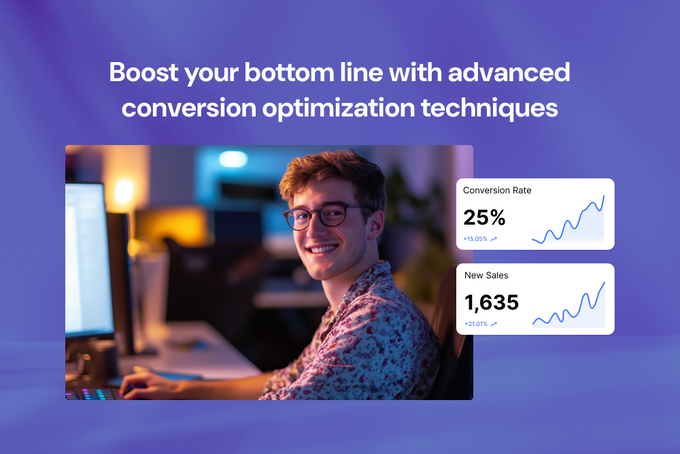
You're pouring time and money into driving traffic to your website. Your blog posts rank, your ads get clicks, and your email lists grow—but your sales stay stagnant. Prospects vanish halfway through checkout. Leads ghost you after downloading a guide.
The truth? Your funnel is leaking. And generic fixes like tweaking button colors or A/B testing headlines aren't plugging the holes. You're not just losing sales; you're burning budgets on broken systems.
The solution isn't another surface-level web conversion tactic—it's advanced conversion funnel optimization. Below, we explore strategies that go beyond "best practices" to fix leaks most marketers miss.
Key takeaways
- Conversion funnel optimization refines each customer journey stage to maximize desired actions.
- The funnel has TOFU (awareness), MOFU (consideration), and BOFU (decision) stages requiring tailored approaches.
- Optimization boosts conversion rates and ROI, lowers costs, improves customer experience, and aligns teams.
- Effective optimization reveals hidden issues and uses advanced techniques to drive conversions.
What is conversion funnel optimization?
Conversion funnel optimization is the process of refining each stage of a customer's journey—from initial awareness to final purchase—to maximize conversions and drive desired actions like sales or signups.
It involves analyzing user behavior, removing friction, and adding incentives to guide prospects toward conversion.
» Learn more about the conversion funnel.
Stages of the conversion funnel
TOFU (top of the funnel)
TOFU focuses on attracting and educating a broad audience about a problem they might not yet recognize. For example, a SaaS company selling project management tools might publish a blog titled "Why 73% of Remote Teams Miss Deadlines" to spark curiosity.
MOFU (middle of the funnel)
At MOFU, prospects are considering solutions but need nurturing to build trust. Using the SaaS example, the company might offer a gated "Remote Team Productivity Audit" tool.
BOFU (bottom of the funnel)
BOFU is where prospects decide to act. The SaaS company might send a "Last-Step Checklist: 5 Questions to Ask Before Buying" to relieve final doubts, paired with urgency tactics like a popup saying, "2 companies in your industry bought today—your cart expires in 20 mins.
» Learn to map keywords to your SEO conversion funnel.
6 benefits of conversion funnel optimization
1. Increased conversion rates
Businesses that implement optimization strategies successfully see measurable improvements in their conversion metrics.
By removing conversion barriers in each stage of the funnel, you can increase the number of qualified leads entering your pipeline and ultimately boost bottom-of-funnel conversion rates.
2. Improved ROI and cost efficiency
Conversion funnel optimization directly impacts your ROI, maximizing the effectiveness of your marketing spend. As optimization increases conversion rates, you get more value from the existing traffic and marketing initiatives.
3. Lower customer acquisition costs
A big financial benefit of using different web conversion tactics to optimize your funnel is the reduced customer acquisition costs (CAC).
By analyzing the pipeline, you can find which channels and strategies deliver the best results. For example, if analysis reveals that social media content generates more leads than other sources, you can reallocate your budget accordingly—reducing spending on ineffective channels.
This targeted approach ensures you direct your resources where they'll have the greatest impact. Over time, as you continue optimizing, CAC will decrease while the customer lifetime value (CLV) will increase. You'll end up with a more favorable business model.
READ MORE: 8 ways to reduce customer acquisition costs
4. Streamlined customer journeys
A potential customer making their way through a conversion funnel wants to move from one action to the next without delays or distractions. Analyzing each step a customer takes (or doesn't take) reveals opportunities to optimize the user journey for higher conversion rates.
This might involve displaying fewer popups, eliminating unnecessary navigation steps, or reducing page load times. A poor experience frustrates visitors, so improving it will reduce bounce rates.
5. Personalized experiences
Personalization is a powerful tool in conversion optimization. Personalized calls-to-action (CTAs) perform 202% better than generic ones.
By optimizing multiple touchpoints in the conversion funnel, you can create a smooth and intuitive experience that keeps users engaged and moving toward conversion. When leads are pleased with their initial interactions with a brand, they're more likely to continue through the conversion process.
6. Synergizing marketing and product efforts
Conversion funnel optimization aligns marketing and product teams, which benefits your customers. By analyzing both conversion and marketing funnels, you can find which marketing strategies are most effective and adjust your approaches accordingly.
For example, if analysis reveals high drop-off rates during product onboarding, product teams can redesign that experience while marketing adjusts messaging to set better expectations. This creates a positive feedback loop where both teams work together to drive growth.
» Explore the stages of the user journey.
10 advanced conversion funnel optimization strategies
1. Match your content to what buyers actually care about
One of the best conversion tactics for your content is separating your funnels and creating content for each stage. Prospects need a tailored experience to move smoothly from awareness (TOFU) to decision (BOFU), and generic content often fails to address evolving needs and objections.
For TOFU
You can focus on problem-awareness content using "ghost keywords" (long-tail, low-competition phrases) to rank for niche searches.
For example, if you have a remote agency, you can publish content like "The Silent Productivity Killer in Remote Teams" with embedded "Save for Later" buttons to encourage micro-commitments.
For MOFU
You should offer solution-focused assets and refresh gated content every 90 days to combat "content decay" and keep your SEO relevant. Try making tools like ROI calculators that adjust results based on a lead's industry.
For BOFU
You need to deliver decision-stage, "savior content" that addresses any last-minute doubts a potential customer might have.
» Check out the crucial metrics and KPIs for each stage of the SEO funnel.
2. Optimize CTAs to guide prospects through the funnel
Another often overlooked conversion funnel optimization strategy is to create relevant CTAs that guide potential customers to the next step without alienating them.
Here's what you can do for each funnel stage:
- For TOFU, use curiosity-driven CTAs like "Discover the Mistake 90% of Teams Make".
- For MOFU, add mid-content CTAs like "Download the Full Case Study."
- For BOFU, test urgency-based CTAs with real-time countdowns.
Tip: Use contextual CTAs within your content and replace generic "Submit" buttons with action-specific ones like "Get My Free Audit."
» Get inspired by these high-converting CTA examples.
3. Find and eliminate invisible conversion barriers
Most brands test headlines or colors, but hidden friction significantly impacts conversions. You can A/B test them to eliminate doubt.
Try micro variations like "Reserve Your Spot" versus "Buy Now" and less obvious elements like form field order and checkout page trust signals. Customers also abandon forms less often when you group fields into logical sections, which they can easily discern.
READ MORE: What is CRO testing? (+ how to do it right in 2026)
4. Uncover untracked conversion sources for better ROI
A big chunk of your conversions might come from untracked sources like Slack, WhatsApp, and podcasts.
To track these sources, you can:
- Add UTM parameters to PDFs and other similar materials
- Use specific referral codes
- Identify "dark" leads by asking, "How did you hear about us?" in post-purchase surveys.
» Check out the best tools to use for conversion optimization.
5. Prime prospects with low-barrier engagement tactics
Users who make micro-commitments are more likely to convert. You should implement small actions that prime customers for bigger commitments later. You can try adding "Bookmark This Guide" buttons on TOFU content and use "Email This Article" as a low-barrier CTA.
6. Stop scaring leads away with annoying forms (ask for less, get more)
You can practice progressive profiling for lead capture to avoid form abandonment from asking too much upfront.
Start with 1-2 fields for TOFU lead magnets and gradually ask for more information on subsequent downloads. Use conditional logic in forms—if a user enters a "@gmail.com" email, ask for the company name in follow-ups.
» Find out how to boost your conversions with AI.
7. Create ads that answer your buyers' "yeah, but…" excuses
MOFU leads need reassurance, not generic ads.
To apply this web conversion tactic, you can retarget pricing page visitors with specific ads addressing competitive advantages and include subtle social proof during demo signups.
8. Make your deal look irresistible
If you want to optimize your conversion funnel without damaging trust, you can use ethical price anchoring + scarcity strategy.
For example, here are two things you can do:
- Show legitimate previous higher prices next to current prices and use inventory-based scarcity messages.
- Add recent purchase notifications on checkout pages can also create subtle urgency.
» Check out these CRO best practices to turn traffic into sales.
9. Ask the one question that stops customers from ghosting you
Many customers won't share the reason they churned if you don't ask them directly, and that's where post-purchase friction mining comes in.
You can embed a simple post-purchase survey using a tool like Hotjar asking "What almost stopped you from buying?" and use responses to create targeted BOFU content that addresses common objections.
10. Stop wasting time on leads who'll never buy
Not all leads are worth pursuing. That's why you should implement negative lead scoring.
You should demote those who open emails but never click and penalize those who repeatedly visit pricing pages without converting. Later, you can re-engage negative-scored leads with targeted "We Miss You" campaigns for better resource allocation.
» Find out what an attribution window is and how it impacts conversions.
Level up your conversion funnel
Conversion funnel optimization isn't about chasing trends or copying competitors—it's about understanding the invisible gaps in your buyer's journey and plugging them with precision.
The strategies outlined here go far beyond surface-level tweaks. Instead, they tap into psychology, hidden data, and technical nuance to turn your funnel into a high-performing engine.
The brands winning today aren't just optimizing funnels—they're engineering them. They know prospects don't follow linear paths. By adopting these tactics, you're future-proofing your funnel.
